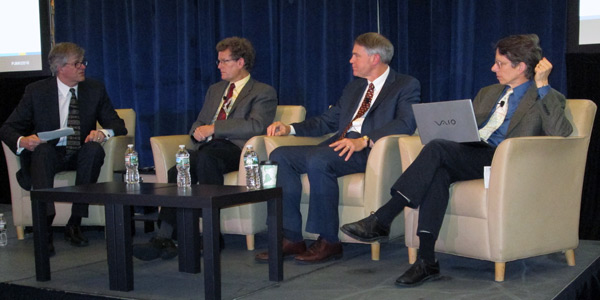By Rory D. Sweeney
WILMINGTON, Del. — The increasing complexity of distribution systems is creating a new “seam” for grid operators, representatives from an industry planning collaborative, the U.S. Department of Energy and Johns Hopkins University said at PJM’s General Session last week on the evolution of system planning.
The growth of distributed energy resources is changing the one-way flow of distribution systems, complicating their relationship with the transmission grid, speakers said.

“Transmission and distribution planning and operations are separate, so the problem becomes understanding the changes on one and how they impact the other,” said David Whiteley of the Eastern Interconnection Planning Collaborative. “In the vertically integrated world, I think the two pieces of planning would merge. … We talk about seams issues with neighbors on transmission. You’re going to have seams issues with the distribution.”
Stan Hadley of the Oak Ridge National Laboratory extended the analysis to the natural gas pipeline network. He noted a study of natural gas sufficiency in New England during the winter that found that the constraint was the lack of pipelines across New York.
“They’ve been pushing away on building those pipelines,” he said.
Whiteley said infrastructure planning has become increasingly complex.

“It’s not a predictable load shape anymore. Generation planning is at arm’s length from transmission planning in many regions of the country, so how can you plan the transmission system if you don’t know where the generation’s going to be?” he said. “You don’t know if a line can be built or what year it will possibly come into service. That complicates the prediction of what the future looks like. All of this takes additional time; it takes additional resources.”
Researchers must understand not only the electric grid but also the natural gas distribution system, physical security issues, political dynamics and an ever-growing list of NERC reliability standards, Whiteley said.
“I used to work at NERC, but even I was shocked at the volume — over 100 standards; 3,000 pages of material on the NERC standards,” he said. “Everything is in the context of the search for what I call the ‘Holy Grail of Planning’: co-optimization of everything.”
Whiteley said incorporating complexity increases understanding of the system but makes planning far more time consuming. He highlighted an EIPC study that defined eight resource-planning futures and analyzed three of them 20 years into the future. The single study took two and a half years, he said.

Having to choose between potential scenarios to study is a dilemma that Johns Hopkins professor Ben Hobbs is attempting to eliminate with his research into “stochastic multistage integrated network expansion.”
“The key thing is we’re making decisions today not knowing which paths we’re going to go down,” he said. “What to build now; what to build later; what’s the value of flexibility. … You’re doing this all at once in one large, linear program.”
While Hobbs’ modeling can take days to run depending on the complexity, it’s already shown success in producing otherwise unseen and money-saving guidance. A study for the Western Electricity Coordinating Council uncovered several insights likely to improve the value of transmission planning over a 40-year outlook by approximately $3.5 billion, he said.
“Under proactive planning, you get more transmission and definitely different siting” for generation, Hobbs said.
Another challenge is integrating individual reports into a cohesive overview, Hadley said. Through the Grid Modernization Laboratory Consortium, he is working on standardizing a “common language” for studies so that results can be compared.
“The idea is being able to show your results and other people can see where you came from,” he said. With current procedures, “you sometimes don’t know what the underlying assumptions were.”



